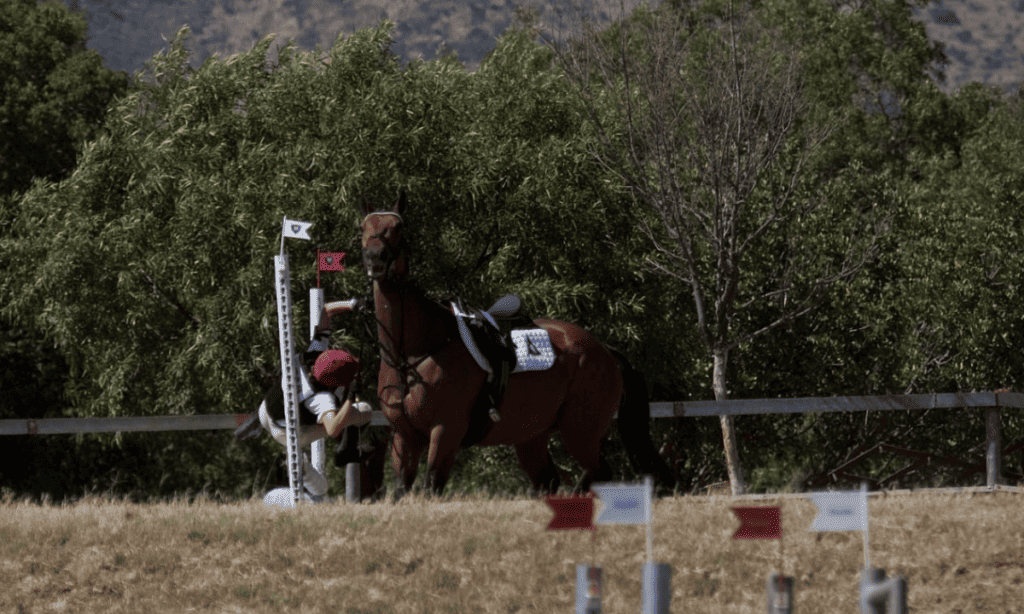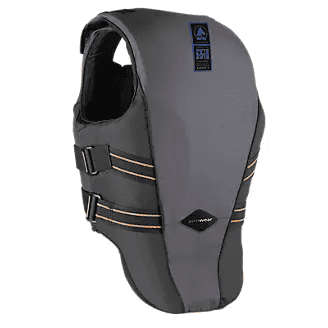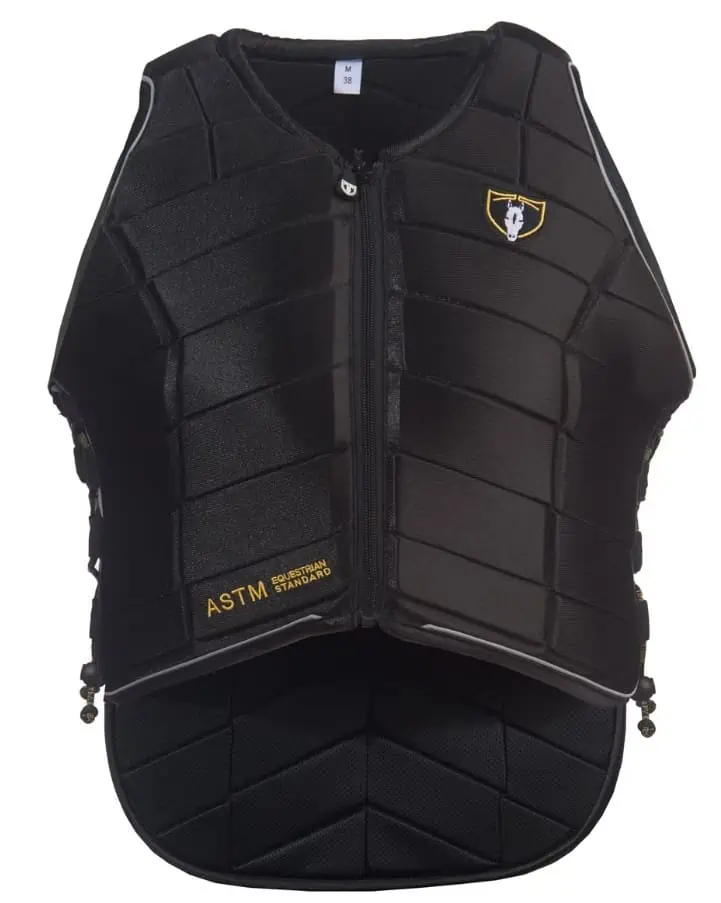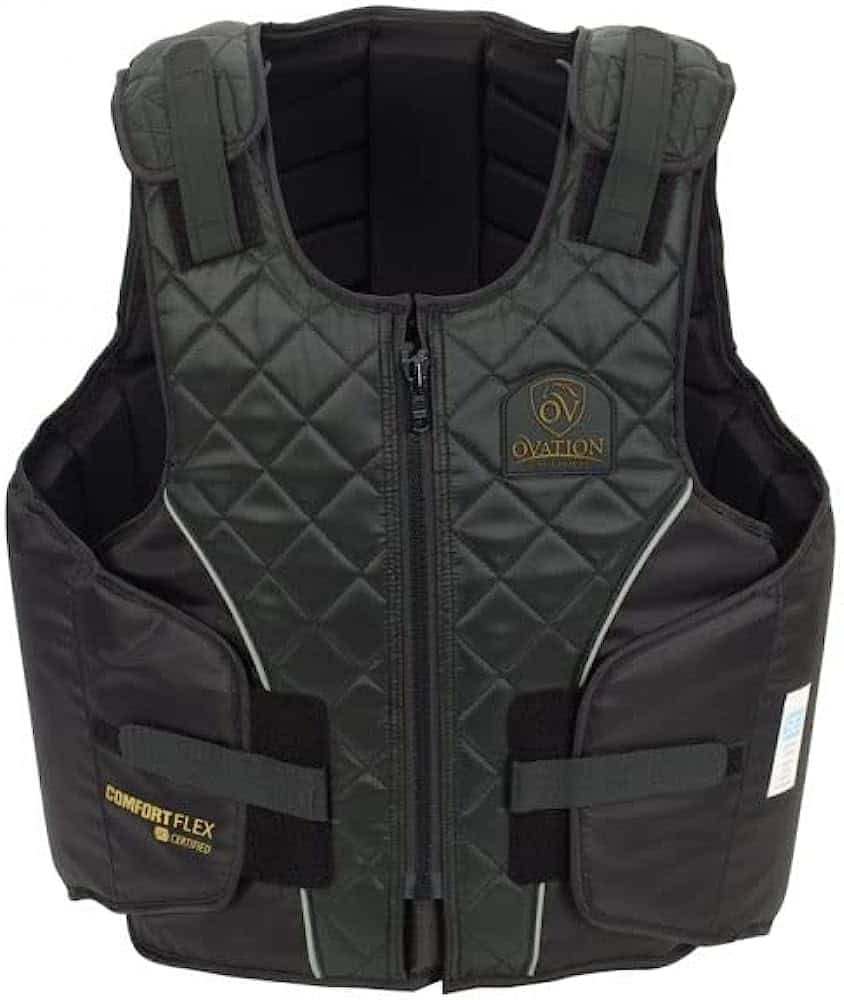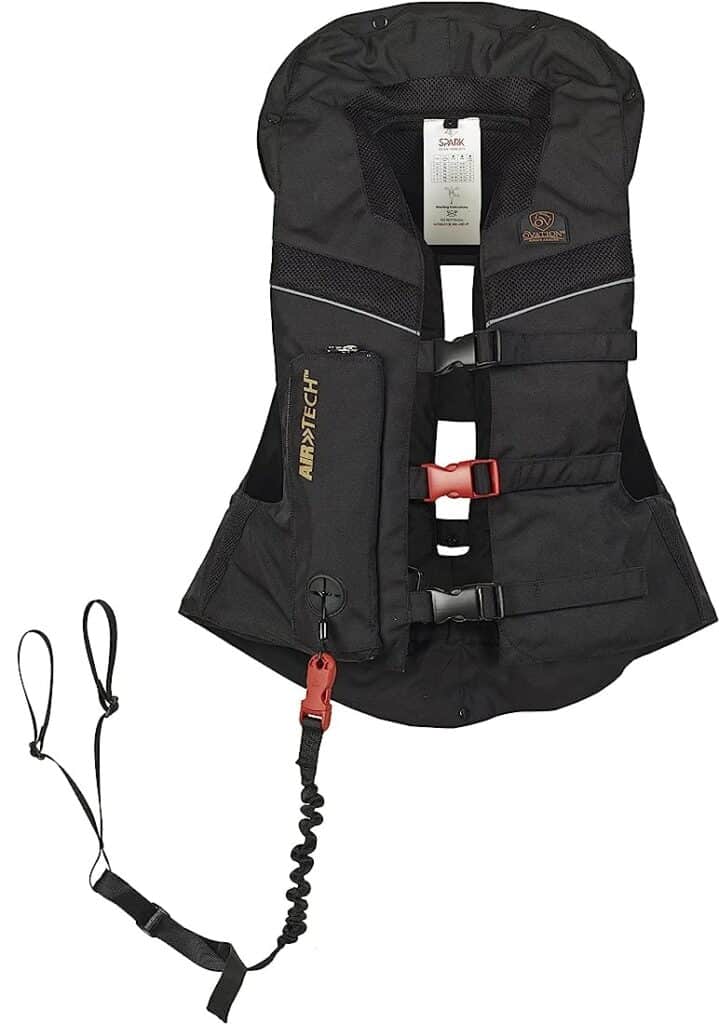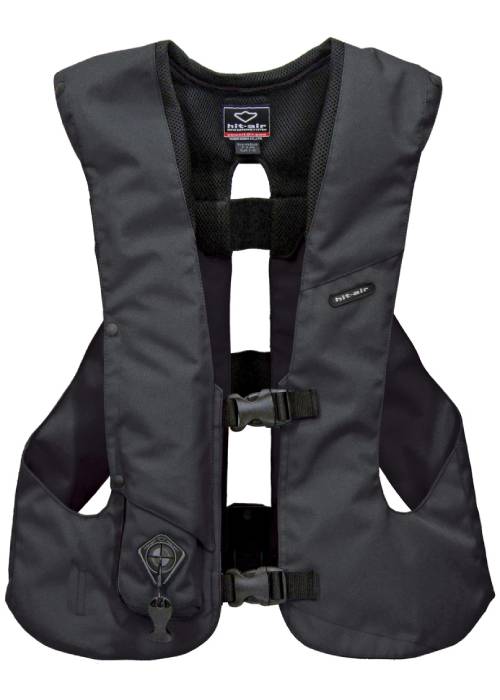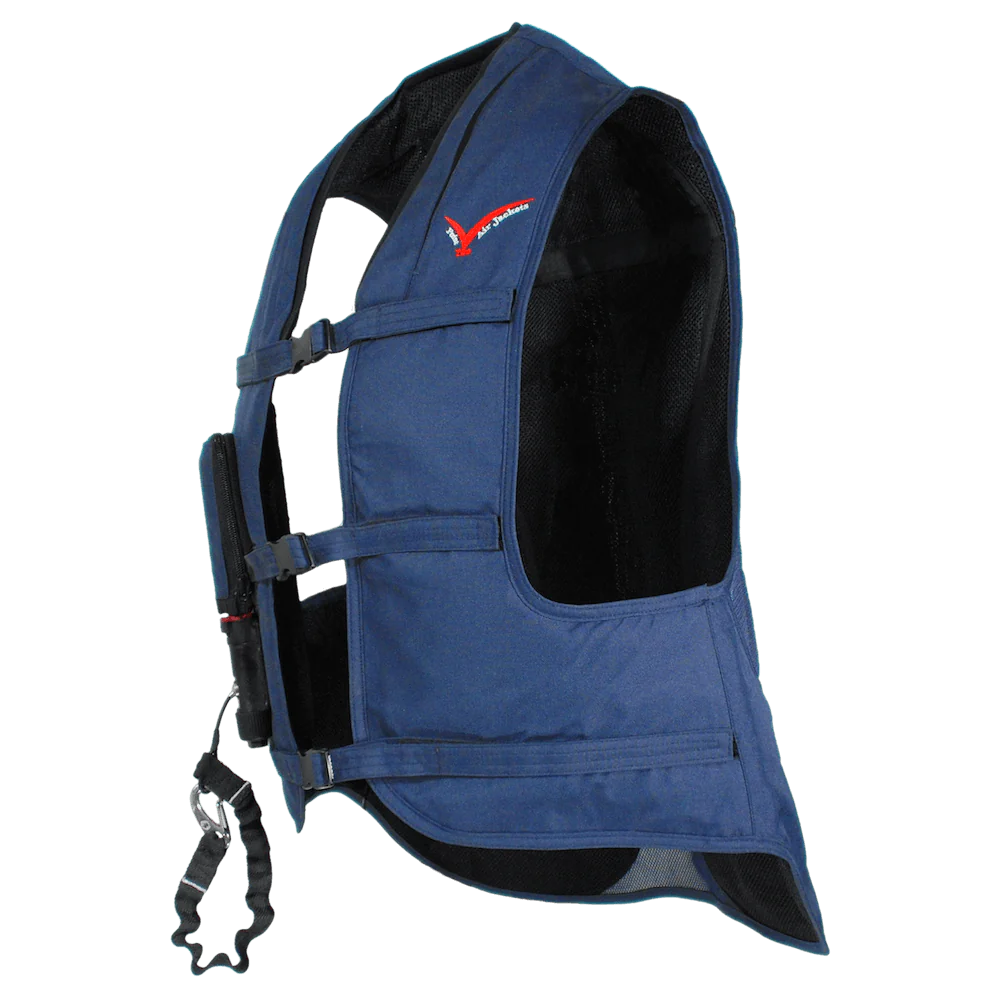- What is a Gaited Horse - October 5, 2023
- What to Look at When Getting a New Farrier - September 21, 2023
- Best Horse Feeds for Older Horses - September 21, 2023
- Bottom Line Up Front: Best Protective Vest for Horse Riders
- Everything You Need to Know About Horse Riding Vests
- What to Look for When Fitting a Horse Riding Vest
- Purpose of a Horse Riding Vest
- Types of Horse Riding Vests
- Pros and Cons of Safety Vests Compared
- Best of the Best: Recommended Horse Riding Vests
- Padded Body Protector Vests for Horse Riding
- Best L3 Padded Horse Riding Safety Vest
- Best Certified Eventing Horse Riding Safety Vest
- Best BETA Level 3 and ASTM Certified Riding Vest
- Air Vest Body Protector Vests for Horse Riding
- Best Basic Air Vest Body Protector Vest for Horse Riding
- Best Original Air Vest Body Protector Vest for Horse Riding
- Most Dynamic Air Vest Body Protector Vest for Horse Riding
- Caring for Your Horse Riding Vest
- FAQs
- Conclusion
Horse riding is so much fun. It’s exhilarating and an out-of-this-world experience … until you have a fall. It’s a dangerous sport, and while falling off is part of riding life, it’s also a cause of massive injuries, trauma, and even death.
In the past, riders believed helmets were all the protection they needed. Thankfully, there have been many advances in riding safety equipment, and body protectors or horse riding vests have become much more popular and affordable. By wearing a quality vest, you can decrease your risk of a serious injury from a fall, and it could save your life.
I had never been all that interested in buying into the “vest-wearing” fraternity—after all, I’m mostly a happy hacker. That is, until the day I had yet another serious fall (while my horse was walking) and cracked my tailbone. Six weeks of extreme agony later, I decided to opt all in and get an air vest.
It would be three months before I had another fall, but I had my vest on, and things went very differently than they could have. This time, it was a high-speed fall with the horse flinging me into the ground.
I remember thinking this was going to be the fall that left me in an ambulance, but instead, I heard a loud hiss (wondered who was drinking soda next to me) and landed on a soft cushion.
My vest had deployed, and I had a safe landing with almost no injuries other than slightly stiff ribs from the inflation. Is it time for you to buy a horse riding vest to keep you safe? Absolutely!
This guide is a beginner’s breakdown of riding vest types and how to decide on a vest that suits you and your riding style. It’s time to invest in your riding safety right now.
Bottom Line Up Front: Best Protective Vest for Horse Riders
Should you wear a horse riding vest or body protector when riding? YES! Just like you’d care for your horse and keep them safe, you should care for your own safety too.
The two main options for body protection vests are:
A Padded Body Protector
The padded vest offers impact cushioning technology to help reduce the energy or force with which a rider takes a hit or falls. Padded vests are not always comfortable and can be hot (especially in warmer climates). The top padded vests include:
- Best L3 Padded Horse Riding Safety Vest: Airowear Outlyne Ladies Vest
- Best Certified Eventing Horse Riding Safety Vest: Tipperary Adult Eventer Pro Vest
- Best BETA Level 3 and ASTM Certified Riding Vest: Ovation Adult Comfort Flex Body Protector
An Air Vest Body Protector
The air vest also supports and cushions the body, reducing the force and energy with which the rider impacts the ground when falling. It is cooler and more comfortable to wear than a body protector. When not inflated, the vest offers zero protection as it’s only a thin bag inside the vest.
- Best Basic Air Vest Body Protector Vest for Horse Riding: OVATION Adult Air Tech II Vest with 65G Cartridge
- Best Original Air Vest Body Protector Vest for Horse Riding: Hit-Air Original
- Most Dynamic Air Vest Body Protector Vest for Horse Riding: Point Two: Pro Air
Everything You Need to Know About Horse Riding Vests
If you’ve always been a happy hacker or Western rider who doesn’t believe in helmets, much less vests, you may find the world of equestrian protective gear (aka safety vests) a bit intimidating. Finding a vest that fits comfortably, fits your pocket, and will work for your preferred type of riding can be difficult.
Fortunately, you’re about to learn all about horse riding vests now:
What to Look for When Fitting a Horse Riding Vest
Fitment for the two types of protective vests for horse riding is somewhat different, and you can’t fit one like the other for serious safety reasons.
The Padded Body Vest for Horse Riding—Fitment
Fitment of the padded horse riding vest is important to ensure it can fulfill its job of protecting you during a fall. Consider these aspects:
- The vest should fit snuggly (use the manufacturer’s guide as each vest is different in design)
- Check if you can freely move your arms when wearing the vest
- The vest should also be comfortable in the saddle and not bounce on the cantle (indicating it’s too long)
- Check that you can turn your head without bumping on the vest or feeling strangled.
Tip: Always tuck your riding shirt into your riding pants or jodhpurs, securing them with a belt to prevent the shirt from riding up under the vest and becoming an awkward bunched mess.
The Air Vest for Horse Riding—Fitment
When your air vest arrives for the first time, you may think you were tricked, and it’s way too oversized to wear. However, measure and order exactly according to the manufacturer’s guide. Here are some very important fitment considerations:
- The vest is loose and baggy when it’s deflated
- When inflated, the vest expands inward, creating an air pillow around the body (if the vest is too small or tight, it could crush your ribs or cause serious bruising)
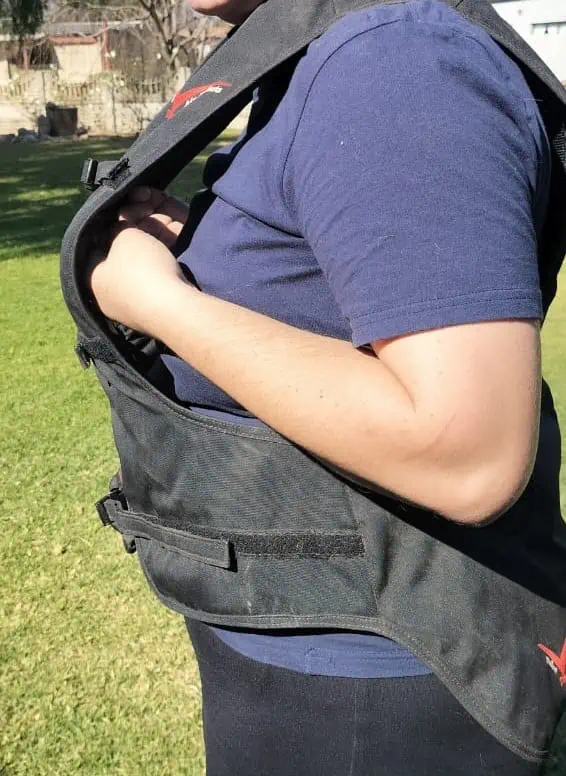
- To check correct fitment, curl both fists and place on your chest with pinky fingers against your chest, this is the room needed for the vest expansion
- The vest is cut away across your sides to allow greater freedom during deployment
Part of the fitment for the air vest is checking that your CO2 canister fits securely.
- Check your CO2 canister is correctly fitted and the right size for your vest and your weight (45 cc for children and 60-65 cc for adults)
- Ensure the saddle strap is correctly fitted to the stirrup bars of the saddle, and attach the lanyard from the vest to the D-ring on the strap once you are in the saddle
Remember: The vest’s deployment mechanism requires as much as 60-80 pounds of pressure to release the peg that pierces the canister to inflate the vest. A regular D-ring on your saddle won’t be able to offer enough resistance for that pressure, causing your vest deployment to fail.
Purpose of a Horse Riding Vest
Why wear a horse riding vest? After all, the cowboys of the glorious days of the West didn’t wear them, right?
While this may be true, many cowboys suffered broken bones, twisted muscles and tendons, spinal damage, brain damage, and more. Why would you want to be severely injured and unable to do the sport you love?
A horse riding vest is a protective vest that covers the rider’s spine, shoulders, ribs, hips, and tailbone. The goal or purpose of a riding vest is to protect the rider during a fall to limit injuries and reduce the severity of these.
Types of Horse Riding Vests
The two main types of horse riding vests are padded vests and air vests. Both are there to protect the rider, but how this happens is slightly different between the two types of vests.
Padded Body Protector
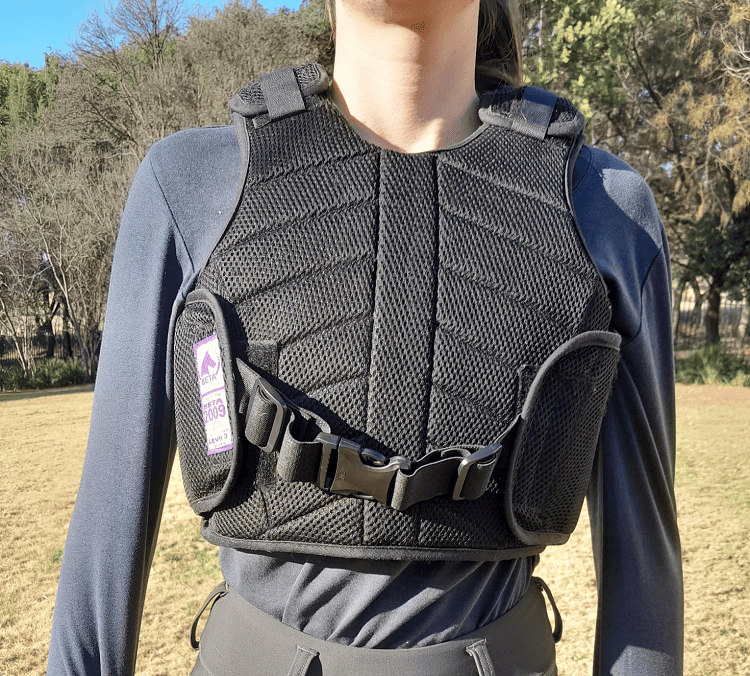
A padded body protector can have solid reinforced plates that cover different parts of the rider’s body with minimal movement. The vest can also consist of smaller segments, which produces a more flexible vest with greater comfort, but the level of protection is less than ideal, and a severe fall will still result in massive physical trauma.
Padded body protector vests that meet at least a BETA level 3 classification are a great beginner’s and professional rider’s protection. It helps reduce the impact’s severity and stabilizes your spinal column and ribs during a fall.
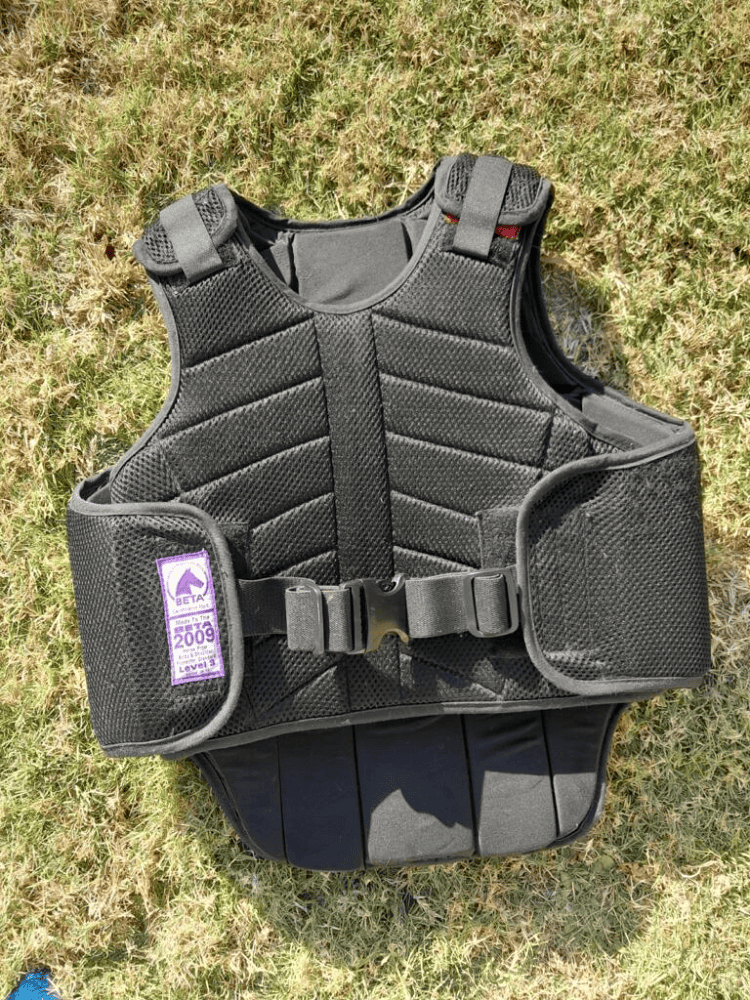
The hardened core reinforces your lumbar area and limits the degree to which your body can unnaturally twist (and that would typically induce a fracture).
However, a level 3 body protector will not prevent severe fractures and neck injuries.
The BETA Classification: BETA stands for the British Equestrian Trade Association, a standard applied to protective vests to determine the level of protection.
Level 3 is the best padded vest safety level, but only if vests were manufactured after 2009, as the vests before then have been discontinued. If you ride competitively, you may have to purchase a new vest to meet the minimum safety requirements of your competition authority.
Air Vest Body Protectors
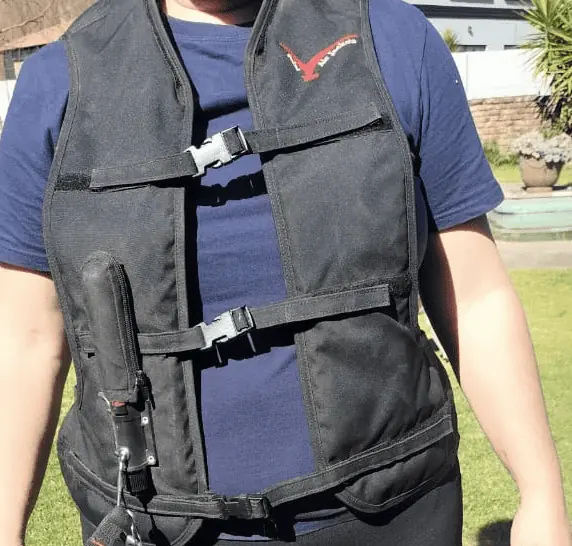
The first air vest on the market was the Hit-Air vest that the Christopher Reeves Foundation designed after the legendary Superman actor suffered a broken neck during a horse riding accident. Since then, other manufacturers have also jumped in with different styles of air vests becoming popular.
The air vest for horse riding is a canvas vest (which may seem oversized) that fits loosely around the rider’s torso. The vest has an inner airbag filled with a canister of compressed CO2 that releases into the vest when a lanyard attached to the horse’s saddle rips out.
When the lanyard pulls a pin out of the vest’s trigger mechanism, a spring-mounted peg pierces the gas canister, causing the vest to inflate in as little as ⅛ of a second. The vest fully inflates before the rider hits the ground, and the vest pads their body.
Pros and Cons of Safety Vests Compared
Of course, I’ve found pros and cons to padded and air (or inflation) vests for horse riding safety. It’s never all moonshine and roses.
Here’s a handy comparison of the pros and cons for your consideration:
| Padded Horse Riding Vests | Air Vests for Horse Riding |
| Pros | Pros |
|
|
| Cons | Cons |
|
|
It may seem that the air vest is more costly than the padded vest and offers no protection unless it deploys and you are mounted on a horse with a saddle. However, it’s not as simple as that. The air vest’s protection level is far superior to the padded vest due to the cover provided to a much larger area of your body.
I found that while riding in my air vest, I gained so much confidence because I realized I was wearing a protective device that would help me not be injured (or help prevent the worst of them)—and even falling in the vest inflicted no pain—it was like landing on air.
Best of the Best: Recommended Horse Riding Vests
So should you buy an air or padded body vest when horse riding? Depending on what type of riding you do, you may actually have to buy both.
If you are a happy hacker or do some elementary equestrian sports, you could do well with an air vest or a padded body protector. However, a padded protector usually doesn’t include a neck protection piece, and more severe injuries result from limited protection than with an air vest.
Those who participate in extreme equestrian sports, such as eventing, would wear both an air vest and a body protector, providing a full spectrum of protection. This video of a severe fall during eventing shows how an air vest and body protector combo saved the rider’s life.
I find that an air vest offers a full range of protection, and if it’s correctly fitted, you can rest assured that a successful deployment of the vest will reduce most injuries. But here are some of the best options on the market to consider.
Padded Body Protector Vests for Horse Riding
Padded body protector vests are protective vests that have a built-up foam filling to help cushion blows or hard landings. Some even have hardened outer shells of PVC. Here are the best options to choose from:
Best L3 Padded Horse Riding Safety Vest
The Airowear Outlyne Ladies Vest is a standard-type padded safety vest for horse riding. It is rated BETA 2018 Level 3. The Level 3 rating is the highest that most horse riders wear and is suitable for all types of riding. Note the “BETA 2018” label, which means the vest was produced in 2018.
If you are competing professionally, this vest would be suitable for all equestrian sports and competition levels. It’s suitable to protect the rider’s body against high-energy dissipation that causes severe injury during falls.
Features
- The Level 3 rating is sufficient for pleasure riding, dressage, jumping, eventing, racing, and more
- Three choice categories for size, fit, and color
- Contoured vest increases body fit and comfort
- The ladies’ vest follows the spinal curvature of a lady
- The chest panels accommodate the natural shape of ladies’ chests
What I Like About This Vest
This vest offers exceptional support, and with the higher area of the shoulders, the rider enjoys more protection of the lumbar region, the ribs, and the shoulders. I felt very well wrapped in the vest, even though it felt quite bulky.
Best Certified Eventing Horse Riding Safety Vest
The Tipperary Adult Eventer Pro Vest is a close-contact vest that provides maximum safety for riders participating in one of the most dangerous horse sports—eventing.
The vest features a set of tectonic plates and a Live-Spine, which moves with the rider, keeping the vest in an optimal position for protection, no matter how the rider twists during a fall.
Features
- Available in multiple sizes, including longer length sizes, to optimize spinal protection (especially on your tailbone)
- Also available in four colors, including black, royal blue, hunter’s green, and navy
- Priced from $359.99 (depending on the size and color)
- Drawstring closure on the sides works with a clip for convenience and accurate fitment
- Zipper front to reduce bulkiness
- Air circulation due to the foam plates that lets air in
- Reflective piping for high visibility if you are missing in low light after a fall
- Meets ASTM standards and is SEI certified
What I Like About This Vest
My personal bug-bear is a smelly vest, and this vest offers an ideal solution. It’s treated with anti-microbial agents to prevent “rider’s stink” building up from long hours in the sun.
Best BETA Level 3 and ASTM Certified Riding Vest
The Ovation Adult Comfort Flex Body Protector offers the best protection, and it’s rated as BETA Level 3 and approved by the American Society for Testing Materials (ASTM). With the unique design, this vest offers double padding for the back, helping to cushion high levels of energy that could cause fractures during a high-impact fall.
Features
- Available in four sizes, from extra small to large
- Hook and loop shoulder and side closures
- YKK heavy-duty zipper for front closure
- Sufficient arm room for greater mobility
- Hook and loop closures increase adjustability for a perfect fit
- Reflective piping helps ensure you’re seen if you ride (or fall) in low-light conditions
- 100% polyester, ensuring the vest is fully washable
- Priced from $229.95 to $259.99 (depending on size)
What I Like About This Vest
When wearing this vest, I felt protected, and my ribs were well-covered, which is a blessing if you’ve ever suffered from broken ribs from a fall.
Air Vest Body Protector Vests for Horse Riding
An air vest is a personal inflation vest that fills with pressurized CO2 when a rider falls from their horse and the lanyard pin is pulled, releasing the gas into the bladder inside the vest. The rider lands on a gas-filled cushion, reducing impact. These are the best options to choose from:
Best Basic Air Vest Body Protector Vest for Horse Riding
The OVATION Adult Air Tech II Vest with 65G Cartridge is a slender cut air vest. It has a padded collar area that also inflates during falls. The vest has a gas canister, the required pin lanyard, and a saddle strap for accurate attachment.
Features
- The gas canister has a zipper closure
- Vest comes with three snap closures
- The 65 grams CO2 canister is suitable for an adult rider
- Can be washed by hand
- Lightweight
- Certified protection
What I Like About This Vest
I love how lightweight and stylish the vest is. However, I didn’t like the padded collar as it can become quite hot when riding in summer. The vest is super comfortable and easy to fit.
Best Original Air Vest Body Protector Vest for Horse Riding
The Hit-Air Original is the first air vest that hit the market, and it’s got everything you want from an air vest. The vest is excellently constructed and considers many features that riders appreciate for comfort and safety.
Features
- The sizes are “bridging” sized, so S/M and M/L
- Three types of lanyards are available, which is great if you’re shorter
- Quiet deployment to avoid spooking your horse
- 48 grams CO2 canister
- The vest protects the neck, spine, ribs, and hips
What I Like About This Vest
The Hit-Air vest is very comfortable, and it offers excellent protection. As a bonus, I really like that you can wear your regular body protector with the vest without feeling extra bulky.
Most Dynamic Air Vest Body Protector Vest for Horse Riding
The Point Two: Pro Air is the vest I chose when I shopped for air vests. It’s incredibly comfortable and one of the air vests most preferred by professional riders.
- Available in 11 funky colors
- 10 size combinations to choose from, including for long and lean riders or shorter and broader riders
- Tested to perform as well as a BETA Level 3 vest and better
- Purchase includes two CO2 canisters, a standard lanyard, and a saddle strap
What I Like About This Vest
The vest has excellent placement of the inflation bladder throughout the vest, and when I had my first fall with the vest, I felt absolutely nothing and landed softer than I did when I flopped into bed. The back section includes an additional sleeve to fit a reinforced spinal protector plate (which you can order from Point Two or biker shops).
Caring for Your Horse Riding Vest
You wear a horse riding safety vest with each ride, but you probably can’t wash it after each ride, so you will have to care for it unless you want to be the smelliest rider on the trail.
Here are a few care tips to help keep you fresh and happy while you hack, jump, race, show, or event.
Daily Care for Horse Riding Vests
- When not being worn, air the vest by hanging it
- Check for signs of damage before each ride
- Clean any stains once you’re done riding
- Don’t leave the vest where UV exposure can damage it
- Avoid leaving the vest in areas where rats may be, such as your feed or tack room
After Fall Care for Horse Riding Vests
So your first fall happened, and after the celebration that you weren’t seriously hurt or that the vest saved your life, it’s time to check it.
For Padded Vests:
- Check for signs of the filling bursting and stitches pulling (visual inspection)
- Show your vest some TLC and clean it up before your next ride
For Air Vests:
- Most manufacturers recommend the vest be sent to their inspection centers to be checked for damage to the air bladder
- If this is not an option, check the vest with a visual inspection
- Reinsert the bladder back into the Velcro pockets if it hasn’t fully deflated and retracted
- Check the vest deployment mechanism for signs of damage
- Unscrew the spent CO2 canister
- Retract the spike and spring, installing the lanyard with ball-pin back into the retaining slot (it holds the spike in tension to pierce the canister on your next fall)
- Once the mechanism is tensioned, insert the new CO2 canister and secure in place
- Give the lanyard a firm tug to ensure it is correctly installed (you should never be able to pull it out by hand once it’s locked in place)
High Use Care—Washing Your Horse Riding Safety Vest
It’s summer, and your vest is becoming really smelly. Time to wash it! Don’t place these vests in a washing machine; they don’t stand up to dry-cleaning, as the chemicals may damage the foam and the air bladder.
Unload the CO2 canister before washing your air vest.
You’ll need a large basin, soap (as little as possible), water, and a sponge or soft scrubbing brush. Work section for section, gently washing it and lightly scrubbing it. Rinse the sections as you finish cleaning them to remove any soap.
Do not wash the area around the deployment mechanism when washing the air vest. It’s not advisable to get water on metal parts as rust could tarnish it.
FAQs
Answer: Horse riding vests help reduce the force of impact, which is why they work. When wearing a correctly fitted riding safety vest, riders will experience less physical trauma from falling off their horse.
Answer: The materials of riding vests may not last indefinitely, and the high-density foam and sponge will eventually compress more and perish. For this reason, a riding vest may become damaged and not meet the minimum safety standards.
When a vest has been worn during multiple falls or if the vest has been in use for more than five years, buy a new vest.
Answer: A safety vest for horse riding can limit your ability to move quickly and hook on your saddle, causing you to lose your balance. However, the rider soon becomes used to riding with the vest, and if it is fitted correctly, the rider will learn to move with the vest.
Conclusion
I don’t ride without my safety vest. It’s a non-negotiable whether I am just taking my horses for a walk or actively training. I know first-hand that an accident happens so quickly.
I know I am supported and protected when I wear my air vest. And while the vest set me back several hundred dollars, I also know it’s earned that back in how many emergency room visits and prolonged (and expensive) recovery time sessions it’s saved me from.
I want to be one of those fine ladies who still blaze trails on their horses at 115 years of age, and ending up in a wheelchair because of a fall would seriously ruin that plan. So I vest up, ride with the appropriate level of protection, and consider the vest as crucial as my riding helmet because my family deserves that from me.
To learn more about different saddles for your horse and which will offer you the best seat for safety, read my guide on saddle types.

